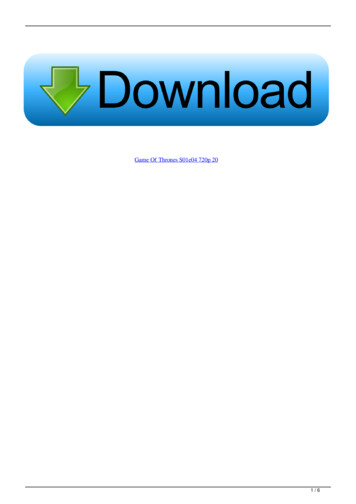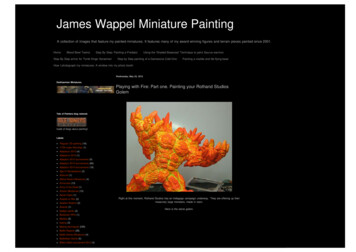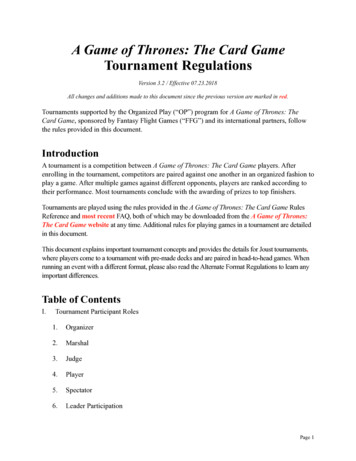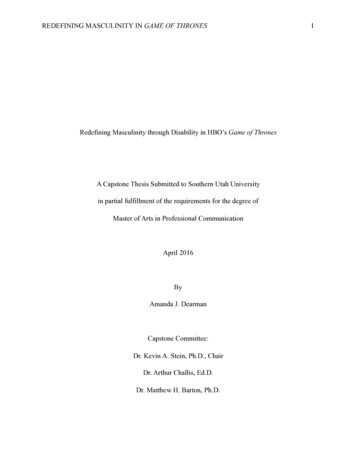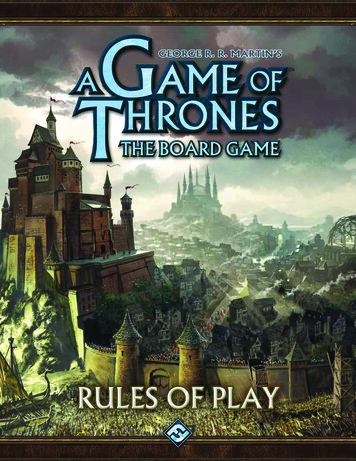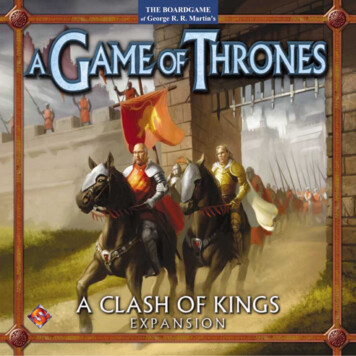
Transcription
A Foreword from theDesignerIt is with no small delight that I am able to present the CLASH OF KINGS expansion for the AGAME OF THRONES board game.The creation of the A GAME OF THRONESboard game itself was a lengthy process thatstarted in the early fall of 2002 and continued tothe late spring of 2003.The design that you have gotten to know drawsits inspiration from both a love of George R.R.Martin's wonderful books and from a deep loveof the classic intrigue/diplomacy games of mygaming past. An obvious inspiration for thegame design is the classic DIPLOMACY (agame that both George and I admire greatly),and a much less obvious inspiration is that ofthe brilliant EL GRANDE by Wolfgang Kramer.I have also heard that A GAME OF THRONEShas passing similarities to the old game KINGMAKER, which I have never played (but Iknow that it certainly shares a theme with AGAME OF THRONES).The initial key concepts of the simultaneousorder system and the structure of the WesterosPhase were designed during countless hours ofbrainstorming and scribbling on notepads atweekend visits to coffee shops. The supply system and the key idea of the central InfluenceTracks came to me after the first testing sessionsat the FFG offices. The first incarnation of the AGAME OF THRONES board game featured adice-heavy battle system, which was scrappedfor the very deterministic and structured systemthat the game has today. In the end I think thatwe ended up with a really solid, elegant, andquite clever system.It is also worth noting that A GAME OFTHRONES would not have achieved the samesuccess and critical praise if not for the stellargraphic design of FFG's Scott Nicely and inputfrom the other excellent developers at FFG. Inmany ways, the A GAME OF THRONES boardgame was a "perfect storm" of game mechanics,beautiful graphics, and a great setting.So why an expansion? Most filmmakers will tellyou that "no film is ever really finished, justabandoned." Unlike my good friend ReinerKnizia, who can brilliantly design (and at a farfaster rate than me) a principal game mechanicfrom the core and build up, I tend to designgames from the "top down." This means that myinitial prototype designs are often riddled withmechanics and complexities that are, one byone, shaved away and/or adapted until they forma simpler whole. Thus, the version of A GAMEOF THRONES that you play is actually a farsimplified and far different version than myoriginal prototype.The success of the A GAME OF THRONESboard game has given me the luxury to addsome more elements to the game, making thegame (in my opinion) deeper, richer, and morecomplex. The additional game options includedin A CLASH OF KINGS are partially derivedfrom my original design, partially born fromnew ideas, and partially in response to playersuggestions. They are ideas nurtured fromcountless games and tempered by the reactionsand observations of the marketplace.As you peruse the CLASH OF KINGS expansion, you will find it a potpourri of options,rather than an ambitious change to the coregame state. These options reflect the ideas andissues I wanted to include in the game for reasons of both theme and actual play. As much asthe original AGOT game remains my definitivevision of the core game, I love the concepts anddetails that this expansion will allow players toexperience.In the end, I very much hope that the CLASHOF KINGS expansion will allow players toapproach AGOT in a new, refreshing way andbe enticed to stay under the exciting blue skiesof Westeros for just a little while longer.Winter is Coming,Christian T. PetersenDesigner, A GAME OF THRONESC.E.O. Fantasy Flight GamesPage 2The Game of ThronesExpansion: A Clash ofKingsThank you for acquiring the A CLASH OF KINGSexpansion for the A GAME OF THRONES board game.Included in this expansion set are a number of excitinggame options that you may introduce to your A GAMEOF THRONES board game experience.Most notably, the A CLASH OF KINGS expansionintroduces the new House Martell hailing from sunkissed southern Westeros. Not only does this additionallow you to play A GAME OF THRONES with sixplayers, but it adds a dramatic new balance of power tothe struggle for the Iron Throne.Here is a complete list of the game options and components that the A CLASH OF KINGS expansion provides:Game Option 1) House MartellGame Option 2) The new House CardsGame Option 3) FortificationsGame Option 4) Siege EnginesGame Option 5) The Ports of WesterosGame Option 6) The One-Time order tokensGame Option 7) Westeros Phase game variantGame Option 8) Battle variantGame Option 9) The revised three-player gameAlso, at the back of this rules set, you will find a comprehensive list of the most frequently asked questions forthe A GAME OF THRONES board game.ComponentsEnclosed in this box you will find the following components:7 House Martell House Cards42 New House Cards6 House Start Cards (for the six-player game)15 House Martell Order tokens20 House Martell Power tokens3 House Martell Influence tokens1 House Martell Supply token4 Wooden House Martell Knight units6 Wooden House Martell Ship units10 Wooden House Martell Footman units18 Wooden Siege Engine units (6 colors)9 Wooden Fortification tokens (Grey)30 One-Time order tokens8 Port tokens1 Influence Track board overlay (in two pieces)1 Westeros board overlay (in two pieces)
Before you play the game for the first time, carefullypunch out the cardboard tokens from their frames so thatthey do not tear.Using this ExpansionWhile the A CLASH OF KINGS expansion introduces asignificant number of new game options, it is intendedthat you should only select the game options that aremost interesting to your play group. Each option is flexible enough to be added to a game of any number ofplayers, and all the options are compatible with eachother.Option One: House Martellchanges the political and military situation of the game,so be ready for a whole new A GAME OF THRONESexperience!Six-Player Game Victory ConditionsIn a six-player game, the player to first control 6 citiesand/or strongholds immediately wins the game.It is recommended that House Martell only beused in a full six-player game.Option Two: The NewHouse CardsThe back of anew HouseCardThe back of anormal HouseCardEnclosed in your A CLASH OF KINGS expansion youwill find the components needed to use House Martell(orange pieces) to play a six-player game of A GAMEOF THRONES.In your CLASH OFKINGS expansion,you will find a complete new set ofHouse Cards for thesix great Houses.The card backs ofthese new HouseCards are illustratedwith the respectiveHouse shields as wellas a crown. This differentiates them fromthe normal House Cardsfound in the basic game that featured only the single House Shield on theback.The new set of House Cards found in A CLASH OFKINGS completely replaces the House Cards providedin the original game and gives players seven entirelynew cards for their House. These new cards have newtext abilities and a higher variance in combat strength,giving the characters from A SONG OF ICE AND FIREa more pronounced role in the game.Setting up the Six Player Game BoardPreparing for the six-player gameThe first thing you will do to prepare for a six-playergame is to place the two map overlays (the 6 PlayerAreas of Influence Overlay and the Southern WesterosOverlay) on top of the original game board as show onthe diagram. These overlays change the geography ofWesteros and the Areas of Influence, allowing for theaddition of House Martell.Note that the "neutral army" Sunspear token found inthe original game is not used in the six-player game.Randomly selecting a HouseNote that, for the six-player game, the starting positions for the houses have changed, and, of course,House Martell has been added. Thus you will find 6new House Start Cards included in this expansion forthe purposes of randomly drawing a players House andfor providing players with their new starting positions.When playing a six-playergame of A GAME OF THRONES,it is necessary for the regular map and theAreas of Influence on the game board to bechanged to accomodate the addition of HouseMartell.Playing the six-player gameAfter you have taken the game out of the box, set upthe game board as illustrated above using the twoMap Overlays that are provided in your A CLASHOF KINGS expansion set.Other than the changes to the game board and the newpositions in the Areas of Influence, the rules and structure of the six-player game remain identical to the regular A GAME OF THRONES game (with the exception of the new victory conditions, see below). Theaddition of House Martell, however, dramaticallyPage 3Note that youplace the Westeros mapoverlay (showing the newSouthern Westeros) directly ontop of the bottom portion of yourregular board by carefully lining upany overlapping areas. Likewise, thenew six-player Areas of Influence overlay is placeddirectly on top of the Areas of Influence on your oldboard, completely hiding the old information.
It is important that you do not mix the two card sets (theold and the new) and that all players play with the sametype of House Cards (the two sets are not designed tointermix). Note that the CLASH OF KINGS expansionincludes two sets of cards for House Martell. One set forplaying against the original House Cards (without acrown printed on the back) and another set for this gamevariant (printed with the crown).Attacking a FortificationThe new House Cards are played exactly like the HouseCards in the original game.Option Three: FortificationsEnclosed in your CLASH OF KINGS expansion, youwill find nine grey wooden Fortification pieces.Fortifications are used to strengthen key defensive areaswhen your forces may be weak or are allocated elsewhere.How to build a FortificationDuring the Resolve Consolidate Power Orders step ofthe Action Phase, rather than executing a ConsolidatePower Order token to receive power, a player maychoose to execute the order and place a Fortification inthe area instead (thus forfeiting any power that he mayhave received).Example: The Baratheon player has placed aConsolidate Power order on King's Landing here duringthe Planning Phase. During the Resolve ConsolidatePower Orders step of the Action Phase, the Baratheonplayer may now execute this order to either a) collectthree power tokens (one for the order itself and an additional two for the two crowns on King's Landing), or b)place a Fortification on the King'sLanding area.The Baratheon player,worried about theLannister armydirectly to theWest,Last turn, the Baratheon player built aFortification in the area of King’s Landing. Thisturn the Baratheon player has again placed aConsolidate Power Order on King’s Landing(hoping to collect 3 power tokens during theResolve Consolidate Power Orders step of theAction Phase).The patience of the Lannister player has runout, however, and the Lannister player decidesto March upon King's Landing with his army of3 Knight units from Blackwater (using a 0March Order).chooses to place a Fortification token on King'sLanding.Effects of a FortificationAn area containing a Fortification grants the defending player an automatic 1 to his total combat strengthand reduces the combat strength of all Knight unitsattacking or supporting the attack by 1. Note that thispenalty is applied to any Knights that are supporting theattack as well as the Knights that are actually marchinginto the fortified area. Also note that defending Knightunits, or Knights supporting the defense, do not sufferthis penalty.Page 4Because of the Fortification in King's Landing,the basic attacking combat strength of theLannister army is 3 (one for each Knight) andthe basic defending combat strength forBaratheon is also 3 (one for each Footman andone for the Fortification token itself).Without the Fortification, the Lannister armywould have been an overwhelming 6 strengthagainst a defending Baratheon strength of 2.Abandoning FortificationsAs soon as a player's last unit leaves the area (by eitherMarching out voluntarily or retreating), the Fortificationis immediately removed. Thus it is not possible to takeover an opponent's Fortification. Note that Fortificationsare always lost when the last friendly unit leaves, even ifthe player has established control over the area with aPower token.Fortifications cannot be placed in a Sea area (you willremember that Sea areas cannot receive ConsolidatePower tokens). Also, Fortifications may not be placed ina Port (see the optional rules for Ports later in this rulesset).
There can only be nine Fortifications in play at any onetime. If all Fortifications are in play, players cannot buildadditional Fortifications until one is removed from theboard and becomes available once again.Since Consolidate Power Orders are resolved in theorder of play, two players will never claim the lastFortification token simultaneously.An area can never contain more than one Fortification.Option Four: Siege EnginesUsing Siege EnginesUnder the right circumstances, Siege Engines are themost potent military unit. Yet they are extremely vulnerable on defense, and they rely greatly on attacking first,which makes initiative and the order of the Iron Throneespecially important.Due to their fragile nature, Siege Engines are best usedas support in attacks against Cities, Strongholds, andFortifications. By supporting rather than marching intobattle themselves, they are not vulnerable to immediatedestruction from retreat in the event that the attack islost.Example of using Siege EnginesEnclosed in the CLASH OF KINGS expansion, you willfind three Siege Engine units for each of the six greatHouses (for a total of 18 wooden tokens). These represent the men, beasts, and wooden devices of destruction,used to assault and besiege Fortifications, Cities, andStrongholds.The Siege Engine is a land unit like Knights andFootmen. Siege Engines count towards Supply limits,and they come into play via mustering like any otherunit. Siege Engines cannot March into a Sea area, yet areallowed to use Sea Transport.When built, Siege Engines, like Knights, cost two mustering points. While mustering, a player may upgrade aFootman to a Siege Engine at the cost of one musteringpoint (following the same rules for upgrading as apply toKnight units).The Effect of Siege EnginesSiege Engines, when attacking (or supporting an attackagainst) a City, Stronghold, or Fortification, have a basiccombat strength of 4. When defending, however, or inall other combat circumstances, a Siege Engine has acombat strength of 0.Siege Engines cannot retreat and are immediatelydestroyed if forced to do so. Siege Engines cannot bechosen as casualties due to House Card sword icons.Note that this forces a losing player to choose other(non-Siege Engine) units to be put to the sword, potentially resulting in devastating losses as both regularcasualties are inflicted and Siege Engine units are automatically destroyed.House Lannister is again marching on King'sLanding. Lannister attacks the Stronghold with anarmy of one Knight and one Siege Engine fromBlackwater, supported by a Stark army of oneSiege Engine and one Footman from CrackclawPoint. This makes for a total attacking combatstrength of 11 (8 for the two Siege Engines, plusone for the Footman and two for the Knight).Page 5The defending Baratheon player has twoKnights, a 2 Defense order, and is supported byhis own fleet of one Ship in the Blackwater Bay.This gives him a defending combat strength of 9.Should Lannister lose the battle, the attackingSiege Engine from Blackwater would be immediately destroyed, but Stark's supporting SiegeEngine would be unharmed.
Option Five: The Ports ofWesterosPort tokenEnclosed in your CLASH OF KINGS expansion, youwill find eight circular tokens, each representing a Portin the land of Westeros.Each Port token belongs to a specific Land and Sea area.If a Land area meets multiple Sea areas, the Port tokenwill denote exactly which Sea area it adjoins.Before beginning a game, place the eight Port tokens onthe map, so that they partially overlap the Land area andthe adjoining Sea area.Placing A Port Token- Ships in a Port area may receive Order tokens as normal (but note that a Defense Order given to a Port is useless, since Ports can never be attacked directly). Undercertain conditions, Ships in a Port may receive theConsolidate Power order, see more details below.- Ports function as special areas between the Land andSea area. Only the player controlling its land area mayuse the Port and is considered the Port owner.- A Port owner's ships may March from the Sea area intothe Port, or may March from the Port into the Sea area.Note that enemy ships may never March into a Portowned by another player.- When a Land area that contains a Port musters newunits, the mustering player may place Ship units directlyinto the adjacent Sea area (using the normal rules ofmustering) or the player may place a newly musteredShip directly on that area's Port. Important note: Playersare allowed to muster new Ship units into a Port,even if the Sea area is occupied by enemy Ships.- Ships in Port may Support a battle in the Sea areabut may not support a battle in the Land area.- Enemy Ships in the Sea area may Raid anySupport, Raid, or Consolidate Power orders in thePort as normal.- If a Port's land area is successfully invaded byanother House, the conquering player may immediately replace the Ship units in the Port area with hisown unused Ship units. That player must still staywithin his supply limits, and if he cannot, he mustremove the Ship units, one by one, until he is incompliance with his Supply limit. Such an invadingplayer may choose not to take over the Ships in thePort and destroy them immediately after invading theLand area. If the player does decide to take theShips, however, he may not choose to destroy themat a later time.- A One-Time order (see later) may never be placed ina Port area.Using PortsPorts represent a new special area governed by specialrules. These are as follows:- Port areas may only be occupied by Ship units.- During the Westeros Phase, when a 'Game of Thrones'Westeros Card is resolved, players receive one Powertoken for every friendly Port containing at least on Shipunit, as long as the Port's Sea area does not containenemy Ship units (in which case the player receivesnothing). This also represents the wealth of trade, asmentioned in the point above.Option Six: The One-TimeOrder Tokens- A Port may never contain more than three Ship units atone time. Ships in Port are still subject to normal supplyrules.- Ships in Port may Raid the Sea area, but not theLand area.As illustrated above, at the beginning of thegame, the Sunspear Port is placed so that itpartially overlaps the land area of Sunspearand the Summer Sea (note that this Port doesnot enter into the Sea of Dorne).mal. This simulates trade with the free cities and theother exotic locations in the world of A Song of Ice andFire.- During the Planning Phase, a player may place aConsolidate Power order on a Port that contains at leastone ship. If, during the Resolve Consolidate PowerOrders step of the Action Phase, there are no enemyships in the Sea area, the player may execute theConsolidate Power order to claim a Power token as norPage 6The square One-Time order tokens represent an excitingaddition to the A GAME OF THRONES planning phaseand add a new layer of strategy options to the PlanningPhase.Playing with One-Time ordersBefore the game begins, each House receives their fiveOne-Time order tokens (identified by the HouseShields). These represent three new special orders for allthe Houses and one new unique special order to eachHouse. Unlike the regular orders, which are retrievedafter each turn and may be used again and again, theOne-Time order tokens are single-use orders and areremoved from the game after they have been in play.Each House is provided with two "Recruit," one "SupplyCaravan," one "Forced March," and one unique order.When playing A GAME OF THRONES with One-Timeorders, the Planning Phase is divided into three separatesegments as follows:The Planning Phase:1) Place One-Time orders2) Place regular orders3) Reveal all ordersDuring step one, in the order of play, each player mayplace one (and only one) One-Time order on the board.As with the normal orders, the One-Time order must beplaced in an area containing at least one unit of a player's House. The One-Time order is placed face down andis revealed at the end of the Planning Phase along withthe regular orders.
Using theOne-TimeOrdertokensExample of Port UsageAlthough eachOne-Time orderrepresents a neworder, it is alsoidentified (on itstop left hand corner) with one of thefamiliar order icons.This denotes the rulesof activation and vulnerability of the One-Time orders.Example: The "Recruit" order (which allows its owner toMuster units in the City or Stronghold of the area) showsthe "Consolidate Power" symbol in its upper left-handcorner. This represents when Recruit can be executedand what its vulnerabilities are (but it does not make it aConsolidate Power order). Thus, the Recruit order isactivated along with the Consolidate Power orders during the Resolve Consolidate Power step of the ActionPhase. Since it is affiliated with the Consolidate Powericon, Recruit is vulnerable to be removed and pillagedby an adjacent enemy Raid order.Note: Since players only have access to a total of fiveOne-Time order tokens, it is quite normal for a player todecide not to place a One-Time order during any givenPlanning Phase (either because he is saving the OneTime order for a later turn, or because he has used all ofhis One-Time orders).After all players, in the order of play, have had a chanceto place a One-Time order, proceed to placing regularorders. Regular orders are placed in the usual fashion,with one important exception:Players are allowed to place a regular order in the samearea as they have placed a One-Time order token. In thisway, it is possible for one area to have two orders: A single One-Time order, plus a single regular order.Two Order TokensWhen an area is assigned two order tokens as describedabove, the following rules apply:1) If the area is Raided, both order tokens are removed(if vulnerable, i.e., March and Defense orders are stillsafe). This can result in a "double pillage."2) If, via a March Order, a player moves all of an area'sunits away (leaving the area empty of units), the secondorder is immediately removed without effect.3) Each order is activated one at a time like normalorders.As mentioned above, after a One-Time order has beenplaced on the board, it does not return to its owner, but isremoved from the game after its activation or loss (placeit back in the box).Page 7As is the rule for normal orders, if an area that contains aOne-Time order is successfully invaded by an opponent,it is removed without effect.The Common One-Time OrdersRecruitThe Recruit order is resolved during the ResolveConsolidate Power Orders step ofthe Action Phase. When executed, Recruit allows its owner toimmediately muster units fromthe City or Stronghold in thatarea. The normal rules for mustering must still be followed, andthe new units must conform to supply limits.RecruitDuring Mustering, the Martell player uses the two Sunspear Stronghold mustering points tomuster one Footman and one Ship unit which he places on the Port of Sunspear (the Shipunit could also have been placed directly into the Sea of Dorne, but not into the Tyrell-occupied East Summer Sea). During the Planning Phase, the Martell player gives the Fleet aRaid order, which he later executes during the Action Phase to cancel a Support order onthe Tyrell fleetExample: During the One-Time Orders Segment of thePlanning Phase, the Stark Player places a Recruit orderon Winterfell. Later (as Winterfell was neither invadedor Raided), the Stark player resolves his Recruit order.Winterfell is a Stronghold and provides two Musteringpoints, so the Stark player upgrades an existing Footmanto a Knight (for one mustering point), and adds an additional Footman to the area (spending the second mustering point).Note that a Recruit order placed in an area without aCity or Stronghold has no effect when resolved.
The Supply CaravanThe Supply Caravan is resolved during the ConsolidatePower Orders step of the Action Phase. When resolved,its player may immediately increase his/her Supply levelon the Supply track by the number of Barrel icons in the area.Thus a player can temporarilyinflate his Supply until thenext Supply card is resolvedduring the Westeros Phase(when the player must movehis Supply level back to its accurate level).Supply CaravanExample of a Forced MarchExample: During the Planning Phase, the Lannisterplayer has placed a Supply Caravan order in theBlackwater area (which contains two Barrel icons).During the Consolidate Power Orders step of the ActionPhase, the Lannister player executes the One-Time orderand moves his supply token from 3 (his current level) to5, allowing him to field dramatically more and largerarmies. Two turns later during the Westeros Phase, aSupply card is drawn, and Lannister must adjust hisSupply to its true level once again.The Forced MarchThe Forced March order is resolved during the ResolveMarch Orders step of the Action Phase.The Forced March can be a powerful toolof mobility, especially whencombined with a regularMarch order. A greattactic is to useyourFor his next March option, the Baratheon player will execute his regular March order in King'sLanding to March against the Lannisters in Blackwater.Forced March order to bring together a substantial force,and later use a regular March order (assuming that onewas placed in the same area during the Planning Phase)to move the gathered force into battle.The Unique One-Time OrdersThe following orders are each unique, with each Housereceiving only one such order for their House.House Greyjoy: The IronFleetThe Iron Fleet is resolved during the Resolve Raid Ordersstep of the Action Phase. Whenexecuting this order, theGreyjoy player may remove anyPage 8two adjacent orders (including Defense Orders andMarch orders, but not other One-Time orders). Note thatThe Iron Fleet, like a regular Raid order, is vulnerable tocancellation by a Raid resolved earlier in the order ofplay. (This goes for all One-Time orders affiliated withthe Raid icon).House Stark: The Young WolfThe Young Wolf is resolved during the ResolveRaid Orders step of the ActionPhase. When executing thisorder, the Stark player mayimmediately move units fromthis area as if a March Orderhad just been executed,except that that no battlemay result from this movement (thus when executingThe Young WolfWhen using a Forced March, you must still stay withinyour supply limitations at all times.The Baratheon player has played his Forced March and a regular March ( 0) order on King'sLanding. During his first March option, he chooses to resolve the Forced March, and moves aKnight unit from Dragonstone (using Ship Transport) and one Footman unit from Crackclaw Pointinto King's Landing.The Iron FleetForced MarchWhen executing a ForcedMarch, a player may immediately move any number offriendly units from one ormore adjacent areas into itsarea. Note that any areasreached by friendly ShipTransport are considered adjacent for the purposes ofForced March. Also note that this order may be usedboth in Sea and Land areas (but, as always, Land unitscannot move into a Sea area or vice versa).
Note that since The Young Wolf order is executed beforethe regular March Orders, it can be used effectively as asurprise advance (particularly in combination with otherregular March orders) or as a quick reinforcement moveto a vulnerable area.House Tyrell: The Might Of Highgarden.The Might of HighgardenThe Might of Highgarden is resolved during the ResolveConsolidate Power Step of the Action Phase. Whenexecuting this order, the Tyrellplayer must immediately discard a House Card from hishand. He may now claim anumber of Power Tokens fromany combination of otherHouses with units adjacent tothe area. The total number of Power tokens claimedin this way must be equal to or less than theCombat Strength of the discarded House Card.If the Tyrell player discards his last House Card in thisfashion, he may immediately reclaim all his discardedcards (as if he had just used his last House Card in a battle).House Martell: The Scorpion's StingThe Scorpion’s StingThe Scorpion's Sting is resolved during the Resolve RaidOrders step of the Action Phase.When executing this order, theMartell player may select anddiscard a single House Cardfrom every House with unitsadjacent to its area, with thefollowing exceptions:1) "Melisandre" (Baratheon) may never be discarded as aresult of the Scorpion's Sting.2) House Martell may not discard a player’s last HouseCard (thus a player with only one card remaining in hishand is not affected by the Scorpion's Sting).The Lion's Cunning is resolved during the ResolveRaid Orders step of the ActionPhase. When executing thisorder, the Lannister playermay name a House with unitsadjacent to its area. Thenamed House may not March,Support, or Raid against (butmay still support in defense of) an area controlledby House Lannister for the remainder of that turn.The Lion’s CunningHouse Lannister: The Lion's CunningHouse Baratheon: The Will of R'hllorThe Will of R'hllor is resolved during the Resolve RaidOrders step of the ActionPhase. When executing thisorder, the Baratheon playermust immediately discard the"Melisandre" House Cardfrom his hand, after which hemay do one of the following:The Will of R’hllorThe Young Wolf, the Stark player cannot move any unitsinto an area containing enemy units).A) remove one Defense Orders from anywhere on theboard, or B) remove one Support order anywhere on theboard.If the Baratheon player is unable or unwilling to discardthe "Melisandre" card, the Will of R'hollor is removedfrom the game with no eff
GAME OF THRONES board game. The creation of the A GAME OF THRONES board game itself was a lengthy process that started in the early fall of 2002 and continued to the late spring of 2003. The design that you have gotten to know draws its inspiration from both a love of George R.R. Martin's wonderful books and from a deep love
